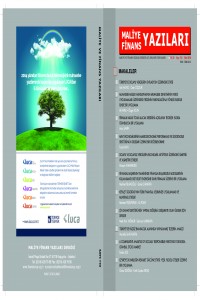Abstract
Çin,
1978 yılından itibaren ekonomi stratejisini kendi kendine yeten bir ekonomi
olmaktan, dışa açık bir büyüme modeli lehine değiştirmiş ve son 40 yıllık
süreçte etkileyici bir büyüme performansı sergilemiştir. İlk aşamada sahip
olduğu bol ve ucuz işgücü sayesinde ülkeye çekmeyi başardığı doğrudan yabancı
yatırımların etkili olduğu yüksek büyüme oranlarını Çin, sermaye birikimine ve
teknolojik gelişmelere yaptığı yatırımlarla sürdürülebilir hale getirmiştir. Bu
gelişmeler sayesinde Çin 1990’lardaki düşük teknolojili ve çoğu zaman düşük
kaliteli ürün ihracatçısı konumundan çıkıp, ileri teknoloji ürünleri imalatında
dünyanın gelişmiş ülkeleriyle yarışan bir ülke haline gelmiştir. Bu makalede
Çin’in bu süreç içerisinde sanayi sektöründe gerçekleştirdiği yapısal değişim incelenmiştir.
Bu incelemenin Hindistan gibi ekonomisi henüz yeterince gelişmeden erken sanayisizleşme
sürecine giren ve Türkiye gibi orta gelir tuzağındaki ülkeler için önemli
çıkarımlar sağlayacağı değerlendirilmektedir.
References
- Aynagöz Çakmak, Ö. (2008). Çin’in Dünya Ekonomisi İle Bütünleşme Süreci ve Türk Sanayisi Açısından Bir Değerlendirme. Süleyman Demirel Üniversitesi İktisadi İdari Bilimler Fakültesi, C. 13, S.1, s.256
- Dasgupta, S. ve Singh, A. (2006). Manufacturing, services and premature deindustrialization in developing countries: A Kaldorian analysis. NU‐WIDER, United Nations University Research Paper, No. 2006/49.
- Dünya Bankası (2018) World Development Indicators veri seti. http://databank.worldbank.org/data/reports.aspx?source=world-development-indicators
- Göçer, İ. (2013). Ar-Ge Harcamalarının Yüksek Teknolojili Ürün İhracatı, Dış Ticaret Dengesi ve Ekonomik Büyüme Üzerindeki Etkileri. Maliye Dergisi, 165, s. 215-240
- Güloğlu, B. ve Tekin R. B. (2012). A Panel Causality Analysis of the Relationship among Research and Development, Innovation, and Economic Growth in High-Income OECD Countries. Eurasian Economic Review, 2 (1), s. 32-47
- Hanson, G. H. ve Robertson, R. (2008). China and the manufacturing exports of other developing Countries. NBER Working Paper Series, 14497.
- IFR (2017a). International Federation of Robotics. World Robotics, 2017 edition.
- IFR (2017b). International Federation of Robotics. Robots: China breaks historic records in automation. IFR pres releases, 16 Ağustos 2017.
- IFR (2018). International Federation of Robotics. Robot density rises globally. IFR press releases, 7 Şubat 2018.
- Liu, X., Buck, T. ve Shu, C. (2005), Chinese Economic Development, the Next Stage: Outward FDI? International Business Review, 14, s. 97-115.
- Lopez Cordova, E., Micco, A. ve Molina D. (2005) How Sensitive Are Latin American Exports to Chinese Competition in the U.S Markets? Dünya Bankası, Policy Research Working Paper, 4497.
- Morrison, W. M. (2018) China’s Economic Rise: History, Trends, Challenges, and Implications for the United States. Congressional Report Service.
- Rodrik, D. (2016). Premature deindustrialization. Journal of Economic Growth, 21(1), 1-33.
- Romer, P.M. (1990). Endogenous Technological Change. Journal of Political Economy. 98(5),71-102.
- Şimşek, M. (2005). Çin Halk Cumhuriyeti’nin Dünya Ticaret Örgütü’ne (WTO) Üyeliğinin Ekonomik Etkileri ve Çin’in Geleceğine İlişkin Senaryolar. Yönetim ve Ekonomi Dergisi, C.12, S.12.
- UNCTAD (2017). United Nations Conference on Trade and Development. Trade and Development Report 2017. Beyond Austerity: Towards a Global New Deal.
- UNIDO (2018). United Nations Industrial Development Organization, istatistiki veritabanı.https://www.unido.org/researchers/statistical-databases
- Qian, Yingyi (2000). The process of China’s market transition (1978-1998): The evolutionary, historical, and comparative perspectives. Journal of Institutional and Theoretical Economics (JITE) Vol 156, No1, pp. 151-171
Abstract
References
- Aynagöz Çakmak, Ö. (2008). Çin’in Dünya Ekonomisi İle Bütünleşme Süreci ve Türk Sanayisi Açısından Bir Değerlendirme. Süleyman Demirel Üniversitesi İktisadi İdari Bilimler Fakültesi, C. 13, S.1, s.256
- Dasgupta, S. ve Singh, A. (2006). Manufacturing, services and premature deindustrialization in developing countries: A Kaldorian analysis. NU‐WIDER, United Nations University Research Paper, No. 2006/49.
- Dünya Bankası (2018) World Development Indicators veri seti. http://databank.worldbank.org/data/reports.aspx?source=world-development-indicators
- Göçer, İ. (2013). Ar-Ge Harcamalarının Yüksek Teknolojili Ürün İhracatı, Dış Ticaret Dengesi ve Ekonomik Büyüme Üzerindeki Etkileri. Maliye Dergisi, 165, s. 215-240
- Güloğlu, B. ve Tekin R. B. (2012). A Panel Causality Analysis of the Relationship among Research and Development, Innovation, and Economic Growth in High-Income OECD Countries. Eurasian Economic Review, 2 (1), s. 32-47
- Hanson, G. H. ve Robertson, R. (2008). China and the manufacturing exports of other developing Countries. NBER Working Paper Series, 14497.
- IFR (2017a). International Federation of Robotics. World Robotics, 2017 edition.
- IFR (2017b). International Federation of Robotics. Robots: China breaks historic records in automation. IFR pres releases, 16 Ağustos 2017.
- IFR (2018). International Federation of Robotics. Robot density rises globally. IFR press releases, 7 Şubat 2018.
- Liu, X., Buck, T. ve Shu, C. (2005), Chinese Economic Development, the Next Stage: Outward FDI? International Business Review, 14, s. 97-115.
- Lopez Cordova, E., Micco, A. ve Molina D. (2005) How Sensitive Are Latin American Exports to Chinese Competition in the U.S Markets? Dünya Bankası, Policy Research Working Paper, 4497.
- Morrison, W. M. (2018) China’s Economic Rise: History, Trends, Challenges, and Implications for the United States. Congressional Report Service.
- Rodrik, D. (2016). Premature deindustrialization. Journal of Economic Growth, 21(1), 1-33.
- Romer, P.M. (1990). Endogenous Technological Change. Journal of Political Economy. 98(5),71-102.
- Şimşek, M. (2005). Çin Halk Cumhuriyeti’nin Dünya Ticaret Örgütü’ne (WTO) Üyeliğinin Ekonomik Etkileri ve Çin’in Geleceğine İlişkin Senaryolar. Yönetim ve Ekonomi Dergisi, C.12, S.12.
- UNCTAD (2017). United Nations Conference on Trade and Development. Trade and Development Report 2017. Beyond Austerity: Towards a Global New Deal.
- UNIDO (2018). United Nations Industrial Development Organization, istatistiki veritabanı.https://www.unido.org/researchers/statistical-databases
- Qian, Yingyi (2000). The process of China’s market transition (1978-1998): The evolutionary, historical, and comparative perspectives. Journal of Institutional and Theoretical Economics (JITE) Vol 156, No1, pp. 151-171
Details
| Primary Language | Turkish |
|---|---|
| Journal Section | Articles |
| Authors | |
| Publication Date | November 10, 2018 |
| Submission Date | August 6, 2018 |
| Published in Issue | Year 2018 Issue: 110 |
Cite
The scope of the Journal of Finance Letters consists of studies in the fields of economics, public finance, finance, and banking.


